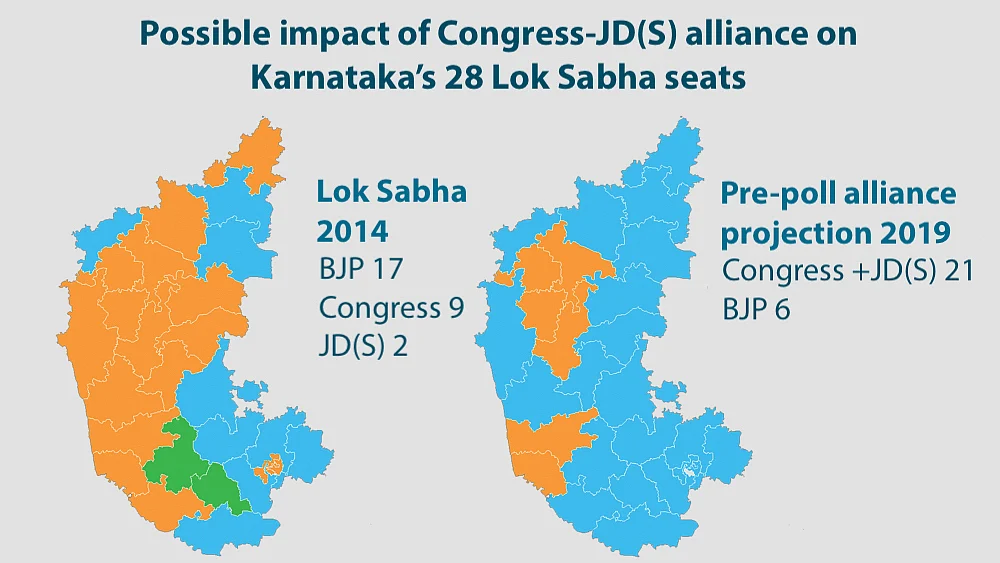Nation
Projected impact of Congress-JD(S) alliance on Karnataka Lok Sabha seats
Date from the recent Karnataka assembly election shows that HD Kumaraswamy was right when he said that if Congress and JD(S) ally, BJP can be reduced to just 6 Lok Sabha seats in the state

Assembly election and Lok Sabha bypoll results since 2014 show that in many states, Opposition unity has the potential to defeat BJP candidates. The most recent bypolls, for which results were declared on May 31, saw unprecedented Opposition unity in several seats, and the BJP could win only 2 out of 15.
Karnataka was the most recent state which witnessed assembly elections. The Congress, BJP and Janata Dal (Secular), the three main players in the state, all fought separately. The JD(S) alone had a tie-up with Mayawati’s Bahujan Samaj Party, and was supported by K Chandrasekhar Rao’s Telangana Rashtra Samiti, which did not contest. In the hung assembly returned by Karnataka, the BJP was the single largest party, but short of the required majority of 112 seats, with just 104 seats. The Congress and JD(S) quickly united and formed the state government with a comfortable majority.
A grand show of Opposition unity was on display at the swearing-in of Karnataka’s new JD(S) Chief Minister HD Kumaraswamy on May 23. This so rattled the BJP leadership that they began targeting possible Opposition coalitions ahead of 2019 as ‘unholy’. The bypoll results of May 31 would confirm BJP’s unease.
Interestingly, HD Kumaraswamy had declared soon after the Karnataka results that if the JD(S) and Congress formed a pre-poll alliance for the 2019 Lok Sabha polls, the BJP would be reduced to just 6 Lok Sabha seats. Is Kumaraswamy’s claim correct? Yes, it is.
Published: 01 Jun 2018, 5:48 PM IST
The Karnataka 2018 assembly results shows that a Congress-JD(S) alliance has the potential to not only sweep the Old Mysore, central Karnataka and Hyderabad Karnataka regions, it could make inroads into the strong BJP regions of coastal Karnataka and Bombay Karnataka as well
We took Karnataka’s assembly results of May 2018, combined the votes of Congress and JD(S)/BSP, and projected these and BJP’s votes onto the map of Karnataka’s 28 Lok Sabha seats (see main image).
The projection of Karnataka’s 2018 assembly results onto Karnataka’s LS seats showed that BJP could indeed be reduced to 6 seats, with the alliance bagging 21. In the 2014 election, the BJP had won 17, the Congress 9 and the JD(S) 2 of Karnataka’s 28 Lok Sabha seats. Karnataka assembly election data shows that Congress votes are spread across the entire state, whereas both JD(S) and BJP have no base in some pockets. In such a scenario, the JD(S) benefits from Congress’ votes in seats where it's main competitor is the BJP. Also, in several assembly seats, it’s the JD(S) and Congress who are the main competitors. Their alliance would not only sweep the Old Mysore, central Karnataka and Hyderabad Karnataka regions, they would make inroads into the strong BJP regions of coastal Karnataka and Bombay Karnataka as well. Note that we could not make a projection for the Central Bengaluru Lok Sabha seat due to delayed election in the Jayanagar assembly seat.
Important caveats are that different issues are at stake in state and Lok Sabha elections. The challenges of vote transfer, seat division and candidate selection are immense. A lot can happen in the 11 months before the next general election. If either the BJP or the Opposition can come up with a strong winning narrative, as the BJP did in 2014, mere arithmetic of party vote bases won’t matter. However, the numbers do indicate that the now formally announced Congress-JD(S) pre-poll tie-up in Karnataka has the potential to massively reduce the BJP’s Lok Sabha tally in the only southern state where the saffron party boasts a real presence.
Published: 01 Jun 2018, 5:48 PM IST
Follow us on: Facebook, Twitter, Google News, Instagram
Join our official telegram channel (@nationalherald) and stay updated with the latest headlines
Published: 01 Jun 2018, 5:48 PM IST